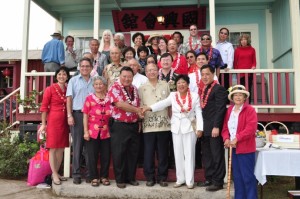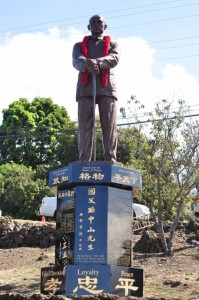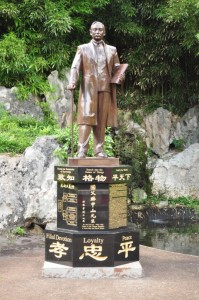VIDEO: Maui Celebrates 100th Anniversary of Modern China
By Wendy Osher
[flashvideo file=http://www.youtube.com/watch?v=O84kQNUeGFI /] County officials and delegates from Taiwan celebrated the 100th year anniversary of the Modern Chinese Revolution and the work of Dr. Sun Yat-sen on Maui.
“It’s a great pleasure and honor for me to have this bronze statue dedicated by the Sun Yat-sen Foundation for Peace and Education in commemoration of the 100th anniversary of the Hsinhai Revolution and the birth of modern China,” said Charles Wong, whose maternal great-grandfather was Dr. Sun Yat-sen.
The statue was one of two unveiled on Maui on Monday–one at Keokea Park in Upcountry Maui, and the other at Kepaniwai Park in Iao Valley.
“I wanted to enhance the historical, cultural and educational value of both of the parks,” said Wong of the improvements.

Mayor Alan Arakawa is pictured here shaking hands with Lily Sun, grand-daughter of Sun Yat-sen. In between Mayor Arakawa and Lily is Minister Wu Yink-yih of the Republic of China in Taiwan. Also featured (on the right of Lily) is Charles Wong, great-grandson of Sun Yat-sen, both of whom flew in from Oahu for the ceremony. The group is standing in front of the Kwock Hing Society Hall in Kula, which was erected in 1907 and was the first two story structure in Kula. Photo courtesy, County of Maui.
Sun Yat-sen arrived in Hawaii in 1879, at the age of 12. He was educated at Iolani and Punahou before moving to Maui to seek refuge at the home of his brother, Sun Mei, at a ranch at Kamaole.
“When he came, he could not speak a single word of English, and in less than three years time, he had gained such a mastery of English that he was able to win second prize in an English grammar competition with native speakers; and was awarded a prize by King David Kalakaua,” said Wong.
On November 24, 1894, Sun Yat-sen came back to Hawaii and established the Revived China Society, as his first revolutionary organization, making Hawaii the birthplace of the Modern Chinese Revolution, according to Wong.
In October, 1895, Sun Yat-sen’s first uprising failed, making the Sun family fugitives of the Qing Imperial Dynasty. It was then that the family moved to Maui to seek refuge with Sun Mei.
From 1895 to 1911, Sun Yat-sen made six trips to major Chinese overseas communities around the world, to preach about his revolution and raise support.
“Sun Yat-sen’s greatest supporter was his own brother,” said Wong. “Sun Mei was one of the wealthiest Chinese in Hawaii during his time, at the turn of the century. He had owned almost 100 properties on Oahu and Maui. He also owned many businesses, including the Kahului General Store, which he established in 1881,” said Wong.
Through the years, Sun Mei eventually sold all of his properties and businesses to support his brother’s revolution.
Out of Dr. Sun’s 10 failed uprisings, four occurred in a single year, in 1907. “It is not a coincidence that Sun Mei declared bankruptcy that very same year,” said Wong.
“In the end, he had dedicated everything that he had, including his own home to the revolution, because what they believed was that their country was on the verge of destruction–and without a country, they had no real home,” said Wong.
In 1911, Dr. Sun’s Hsinhai Revolution successfully overthrew the Qing, China’s last imperial dynasty. “For more than 2,000 years, China had a dynastic imperial system, and then after Dr. Sun’s revolution, he created a modern democratic republic–the first republic in Asia, and so that ended the dynastic system,” said Wong.
He explained that in the republic, all of the people are free and equal. “Sun Yat-sen had a famous saying, which means that all under heaven are equal, or the world belongs to all,” said Wong.
“The specific context in which Sun Yat-sen used it was, for thousands of years, the country, and all of its people were subjects of the emperor. After Sun’s Revolution overthrew the dynastic system and the emperor, the republic belongs to all of the people. All of the people are free and equal in the republic,” he said.
The Chinese Garden, here at Kepaniwai is dedicated to the Chinese immigrants who contributed to the early development of Maui in the form of economic infrastructure, clearing the land, building roads, and constructing irrigation ditches.
“When I came here a year and a half ago, I noticed there was no history of Sun Mei here on Maui, so I wanted to enhance the historical, cultural and educational value of both of the parks,” said Wong.












